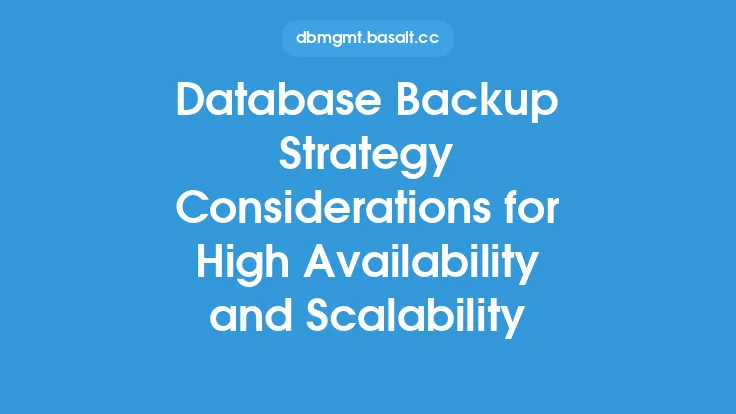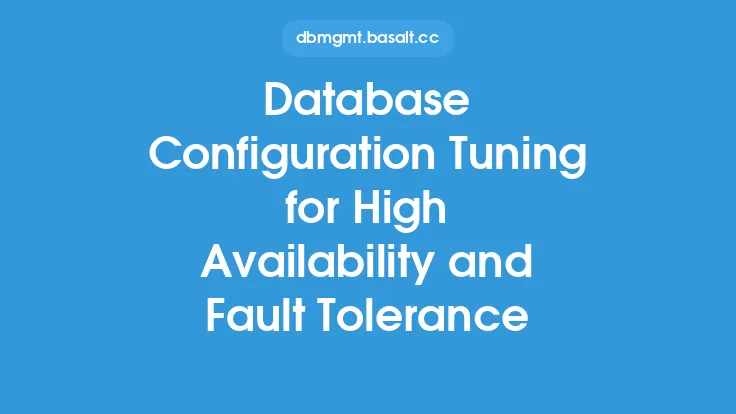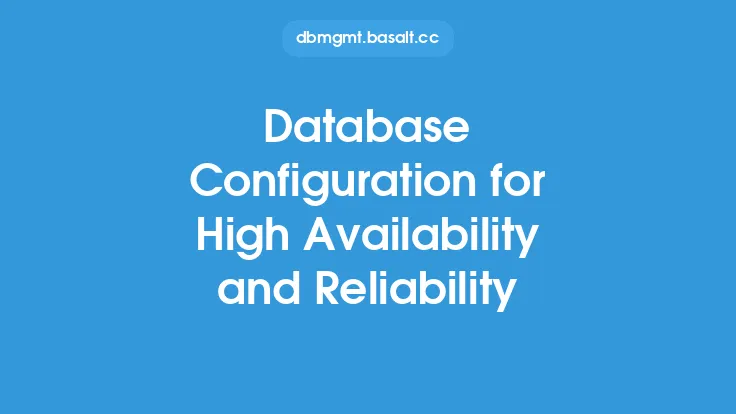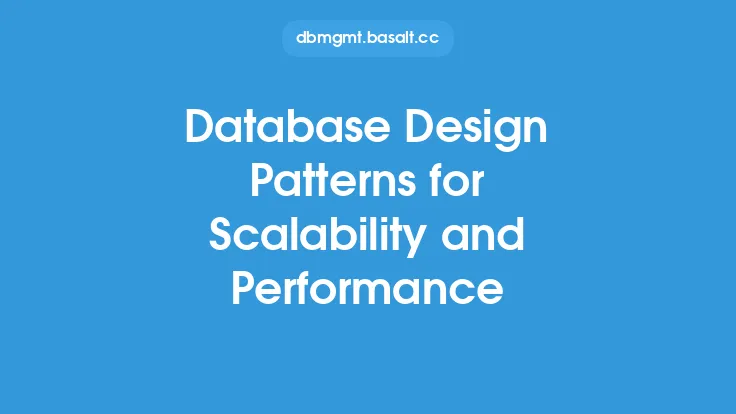When it comes to deploying databases, high availability and scalability are two of the most critical factors to consider. A highly available database is one that is always accessible and can withstand failures without significant downtime, while a scalable database is one that can handle increased traffic and data without a decrease in performance. In this article, we will explore the concepts and techniques involved in deploying databases for high availability and scalability.
Introduction to High Availability
High availability is a measure of a database's ability to remain accessible and functional even in the event of failures or disruptions. This can include hardware failures, software bugs, network outages, and other types of disruptions. A highly available database is designed to minimize downtime and ensure that data is always accessible to users. There are several techniques that can be used to achieve high availability, including replication, clustering, and load balancing. Replication involves duplicating data across multiple servers to ensure that data is always available, even if one server fails. Clustering involves grouping multiple servers together to form a single system, which can continue to function even if one server fails. Load balancing involves distributing traffic across multiple servers to ensure that no single server is overwhelmed and becomes a single point of failure.
Introduction to Scalability
Scalability is a measure of a database's ability to handle increased traffic and data without a decrease in performance. A scalable database is designed to handle growing demands without requiring significant changes to the underlying architecture. There are several techniques that can be used to achieve scalability, including horizontal partitioning, vertical partitioning, and distributed databases. Horizontal partitioning involves dividing data into smaller chunks and storing each chunk on a separate server. Vertical partitioning involves dividing data into smaller chunks based on the type of data, such as storing all user data on one server and all product data on another. Distributed databases involve storing data across multiple servers, which can be located in different geographic locations.
Database Replication for High Availability
Database replication is a technique used to achieve high availability by duplicating data across multiple servers. There are several types of replication, including master-slave replication, master-master replication, and multi-master replication. Master-slave replication involves designating one server as the primary server and duplicating data to one or more secondary servers. Master-master replication involves designating multiple servers as primary servers and allowing data to be written to any server. Multi-master replication involves designating multiple servers as primary servers and using a consensus protocol to ensure that data is consistent across all servers. Replication can be synchronous or asynchronous, depending on the needs of the application. Synchronous replication involves writing data to all servers simultaneously, while asynchronous replication involves writing data to the primary server and then replicating it to secondary servers.
Database Clustering for High Availability
Database clustering is a technique used to achieve high availability by grouping multiple servers together to form a single system. Clustering involves using a shared storage system and a clustering software to manage the servers and ensure that data is always available. There are several types of clustering, including shared-disk clustering, shared-nothing clustering, and shared-everything clustering. Shared-disk clustering involves using a shared storage system to store data, while shared-nothing clustering involves using separate storage systems for each server. Shared-everything clustering involves using a combination of shared and separate storage systems. Clustering can be used to achieve high availability, scalability, and performance, making it a popular choice for many applications.
Load Balancing for Scalability
Load balancing is a technique used to achieve scalability by distributing traffic across multiple servers. Load balancing involves using a load balancer to direct traffic to the most available server, based on factors such as server load, response time, and availability. There are several types of load balancing, including round-robin load balancing, least connection load balancing, and IP hashing load balancing. Round-robin load balancing involves directing traffic to each server in a rotating sequence, while least connection load balancing involves directing traffic to the server with the fewest active connections. IP hashing load balancing involves directing traffic to a server based on the client's IP address. Load balancing can be used to achieve scalability, high availability, and performance, making it a popular choice for many applications.
Distributed Databases for Scalability
Distributed databases are a type of database that stores data across multiple servers, which can be located in different geographic locations. Distributed databases are designed to handle large amounts of data and traffic, making them a popular choice for many applications. There are several types of distributed databases, including sharded databases, replicated databases, and federated databases. Sharded databases involve dividing data into smaller chunks and storing each chunk on a separate server. Replicated databases involve duplicating data across multiple servers to ensure that data is always available. Federated databases involve using a combination of sharding and replication to store data across multiple servers. Distributed databases can be used to achieve scalability, high availability, and performance, making them a popular choice for many applications.
Best Practices for Database Deployment
When deploying databases for high availability and scalability, there are several best practices to keep in mind. First, it's essential to choose the right database management system (DBMS) for the application. Different DBMSs have different strengths and weaknesses, and some are better suited for high availability and scalability than others. Second, it's essential to design the database architecture with high availability and scalability in mind. This can involve using techniques such as replication, clustering, and load balancing to ensure that data is always available and can handle increased traffic. Third, it's essential to monitor the database regularly to ensure that it is performing optimally and to identify any potential issues before they become major problems. Finally, it's essential to have a disaster recovery plan in place in case something goes wrong. This can involve using techniques such as backups, snapshots, and replication to ensure that data is always available, even in the event of a disaster.
Conclusion
Deploying databases for high availability and scalability requires careful planning and design. By using techniques such as replication, clustering, load balancing, and distributed databases, it's possible to create a database that is always available and can handle increased traffic. By following best practices such as choosing the right DBMS, designing the database architecture with high availability and scalability in mind, monitoring the database regularly, and having a disaster recovery plan in place, it's possible to ensure that the database is always performing optimally and is able to meet the needs of the application. Whether you're deploying a database for a small application or a large enterprise, high availability and scalability are essential for ensuring that data is always available and that the application is always performing optimally.





